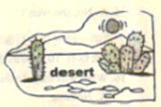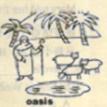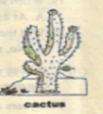
题目列表(包括答案和解析)






| A.it is sandy | B.there is so little rain |
| C.the wind is strong | D.there is no water deep under the ground |
| A.围堵 | B.讨好 | C.释放 | D.吸收 |
| A.the sunlight is too strong in the day | B.they need to see and hear well at night |
| C.it is very cold at nigh | D.they store water in them. |
| A.storing water in side their bodies | B.drinking water as much as they can |
| C.staying underground | D.growing lots of plants |
| A.Desert people like to live in the desert though life is hard. |
| B.People in the desert usually fry eggs on the ground. |
| C.Camels have special fur to store water. |
| D.All the deserts are covered in sand. |

| A.you are already out of a town |
| B.you still have thirty kilometers to go |
| C.there must be many houses and buildings not far away |
| D.there must be a town thirty k8ilometers away |
| A.traffic | B.subway |
| C.turning | D.danger |
| A.each of the eight signs |
| B.either of Signs 2 and 3 |
| C.all of Signs 2, 4, 6 and 7 |
| D.any of Signs 3, 5, 6 and 7 |
| A.teach drivers lesson |
| B.make drivers even safer |
| C.stop cars going there |
| D.learn another kind of language |
| A.Another language. |
| B.On the road. |
| C.What to do. |
| D.Traffic signs. |
A sign is another kind of language. Here are some of them that you see on the roads.
Number one is a sign with the number thirty on it. When drivers see this sign , they must not go at more than thirty kilometers can hour. We see this sign when we are getting near a town. Number two is a sign that we're near a crossing. We must drive carefully. Number three is a sign that there is a bend in the road. Again, we must drive slowly and carefully. It is not safe to go round a bend very fast. Number four is a sign that there is another road coming in from the right. There is a junction at this place. Number five is a sign that there is a hill and number six is a sign that the road gets narrow. Drivers must go slowly and carefully. Number seven has the word “ SCHOOL” on it. This is a sign that there is a school at the side of the street or the road. Perhaps there are children going to or leaving school. So drivers must look carefully and go slowly. Number eight is a sign with the letter “ P ” on it. The letter “ P ” means “ Parking ”. At some places, there're the signs “ No parking ” or “ No waiting”. If a driver leaves his car near one of these signs, a policeman may come and write down the number of his car.
【小题1】At the places where you see Sign 1, .
| A.you are already out of a town |
| B.you still have thirty kilometers to go |
| C.there must be many houses and buildings not far away |
| D.there must be a town thirty k8ilometers away |
| A.traffic | B.subway |
| C.turning | D.danger |
| A.each of the eight signs |
| B.either of Signs 2 and 3 |
| C.all of Signs 2, 4, 6 and 7 |
| D.any of Signs 3, 5, 6 and 7 |
| A.teach drivers lesson |
| B.make drivers even safer |
| C.stop cars going there |
| D.learn another kind of language |
| A.Another language. |
| B.On the road. |
| C.What to do. |
| D.Traffic signs. |
A big, mighty(高大的) tree stood in a forest. Its branches(树枝) spread out and its roots (根) went deep in the earth. A lot of people came here to have a rest under it. And a lot of birds stood on its branches to sing and dance. The big tree was very proud all the time.
At the foot of the tree, there was a little plant. The plant was thin, and seemed to be blown down by any of a little wind.
One day, the two neighbors were having a little chat.
“Well, little one,” said the tree to the plant, “why not put your feet deeply in the earth, and raise your head high in the air as I do?”
“I see there is no need to do so,” said the plant with a smile. “In fact, I think I may be safer in this way.”
“Safer?” said the tree. “Are you safer than I am? Do you know how deep my roots are in the earth and how strong my branches are? Who can possibly pull me out by the roots or bow my head to the ground?” And the tree didn’t want to say anything to the weak plant.
But the tree was to regret its words very soon. One evening, a great hurricane(飓风) came. It blew the trees off their roots and almost destroyed the forest completely. It uprooted(将……连根拔起)the mighty tree and blew it away with great force.
When the storm had gone, the villagers living nearby came to check the damage. The mighty tree lay on the ground, but the little plant still stood there.
【小题1】Who was the big tree’s neighbor?
| A.People. | B.Birds. | C.A little plant. | D.Branches. |
| A.Because a lot of people came to have a rest under it. |
| B.Because it was tall and thick. |
| C.Because a lot of birds stood on its branches to sing and dance. |
| D.All of the above. |
| A.Because the big tree was tired. |
| B.Because the little plant knew less than the big tree. |
| C.Because the strong wind came. |
| D.Because the big tree looked down upon(看不起)the little plant. |
| A.They saw the forest was flooded. |
| B.They saw the big tree lying on the ground. |
| C.They saw the big tree was still mighty. |
| D.They saw some birds singing on the little plant. |
| A.Trees in the Forest. | B.A Mighty Tree. |
| C.Trees and Plants. | D.A Clever Plant. |
A Brown University sleep researcher has some advice for people who run high schools: Don’t start classes so early in the morning. It may not be that the students who nod off at their desks are lazy. And it may not be that their parents have failed to enforce(确保) bedtime. Instead, it may be that biologically(生物学上)these sleepyhead(贪睡者)students aren’t used to the early hour.
“Maybe these kids are being asked to rise at the wrong time for their bodies,” says Mary Carskadon, a professor looking at problem of adolescent (青春期的)sleep at Brown’s School of Medicine.
Carskadon is trying to understand more about the effects of early school time in adolescents. And, at a more basic level, she and her team are trying to learn more about how the biological changes of adolescence affect sleep needs and patterns(方式).
Carskadon says her work suggests that adolescents may need more sleep than they did at childhood, no less, as commonly thought.
Sleep patterns change during adolescence, as any parent of an adolescent can prove. Most adolescents prefer to stay up later at night and sleep later in the morning. But it’s not just a matter of choice---their bodies are going through a change of sleep patterns.
All of this makes the transfer(迁移)from middle school to high school---which may start one hour earlier in the morning----all the more difficult, Carskadon says. With their increased need for sleep and their biological clocks set on the “sleep late, rise late” pattern, adolescents are up against difficulties when they try to be up by 5 or 6 a.m. for a 7:30 a.m. first bell. A short sleep on a desktop may be their body’s way of saying. “I need a timeout.”
【小题1】Carskadon suggests that high schools should not start classes so early in the morning because _______.
| A.it is really tough for parents to enforce bedtime |
| B.it is biologically difficult for students to rise early |
| C.students work so late at night that they can’t get up early |
| D.students are so lazy that they don’t like to go to school early |
| A.turn around | B.agree with others | C.fall asleep | D.refuse to work |
| A.Adolescents depend more on their parents. |
| B.Adolescents have to choose their sleep patterns. |
| C.Adolescents sleep better than they did at childhood. |
| D.Adolescents need more sleep than they used to. |
| A.Adolescent health care. |
| B.Problems in adolescent learning. |
| C.Adolescent sleep difficulties. |
| D.Changes in adolescent sleep needs and patterns. |
湖北省互联网违法和不良信息举报平台 | 网上有害信息举报专区 | 电信诈骗举报专区 | 涉历史虚无主义有害信息举报专区 | 涉企侵权举报专区
违法和不良信息举报电话:027-86699610 举报邮箱:58377363@163.com